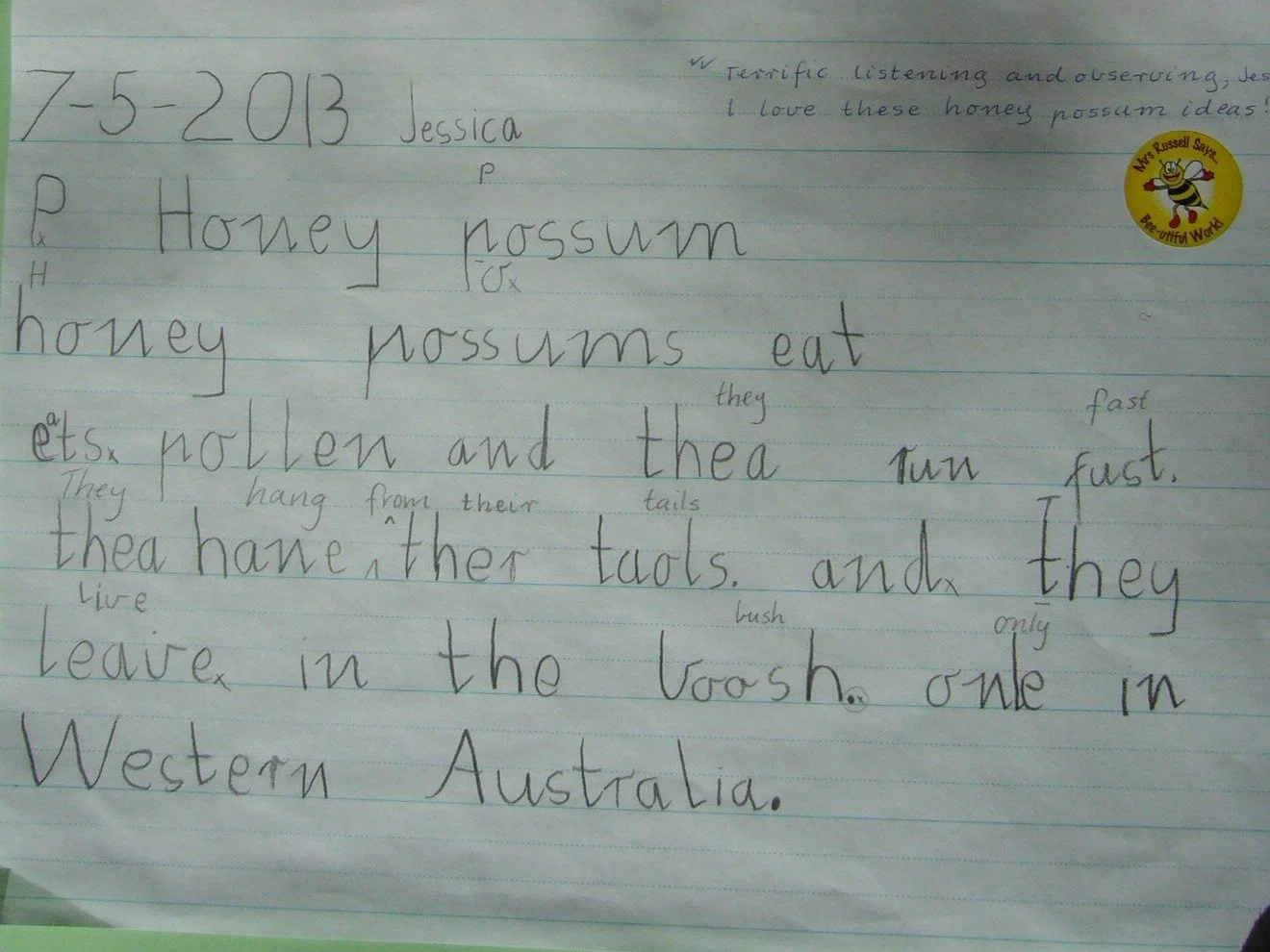In the Classroom
Meet a Honey Possum
Activity
How Big are Honey Possums?
The tiny size of the Honey possum can engage students with the following activity
MATERIALS
• A balance weighing to 0.1g (from the science room)
• Glad wrap, cut into squares (about 8cm square)
• Granulated sugar
• Wool, or cotton pieces (about 10-12cm)
METHOD
1. Weighing a simulated form of a Honey possum is best done by an advanced student, or the teacher.
2. Spread the square of wrap on the balance and slowly add the sugar crystals until the balance measures about 10g.
3. Carefully gather the edges of the wrap, squeeze them together and tie off, leaving the sugar crystals in a small ball contained in the parcel.
4. The parcel represents a mother (female) Honey possum.
5. Repeat the exercise, weighing out 6g sugar. This parcel represents the father (male) Honey possum.
6. Distribute the parcels amongst the students, allowing them to feel the weight.
7. You may like to extend the weighing activity to include two or three babies, weighing out 2g sugar in each case. This is the weight when they leave the pouch and are on their own.
A Tale of Two Honey Possums from:
https://www.amazon.com.au/Tale-Two-Honey-Possums/dp/0646502468
Also available from felicity.bradshaw@aapt.net.au
Activity
Read a Tale of Two Honey Possums:
After reading, introduce and discuss with students the following facts:
1. Where do Honey possums live?
In the south-west corner of Western Australia (see Figure) – nowhere else in the world.
2. What do they eat?
Honey possums eat only pollen and nectar from flowers. They have favourite flowers from bushes such as banksias, grevilleas, hakeas, and eucalypts. Flowers from these plants produce a lot of nectar and pollen. Do students remember where the pollen and nectar are located in a flower? And discovered how sweet it is? (Activity 6 – the Bush as Food).
3. How do they eat?
Honey possums have no teeth for chewing. These have disappeared or turned into stumpy pegs, because for millions of years they have been drinking nectar, and brushing pollen into their mouth, with their brush-tipped tongue. It is very long, about 2cm. (Demonstrate).
4. How much do they eat?
A honey possum that weighs 9g eats 7ml nectar and 1g pollen every day[3]. That means it eats nearly as much as it weighs! You might relate this to the food a student eats and their weight.
5. What does the Honey possum do if there is not enough to eat?
When there are not many flowers, the Honey possum has no energy to search for food; it curls up (as in the photo) and has a short sleep, called ‘torpor’.
6. How does the Honey possum wake up?
They shiver, and shiver, and finally uncurl their body.
7. How many babies does a mother Honey possum have?
Two or three about twice a year (if she gets enough food).
8. How big are the babies when they are born?
The same size as a grain of rice. Distribute rice grains amongst students.
9. Where does a Mother Honey possum put her babies?
In her pouch. That’s where her nipples are where she feeds the babies on milk.
10. Another name for a pouch is ‘mar-soup-ee-um’ (marsupium).
That’s why Honey possums are called marsupials (mar-soup-ee-als). Can students name any other marsupials? (see Glossary).
11. Are Honey possums important in the bush?
Yes. When they travel from flower to flower, looking for food (remember what they eat?), they pass pollen grains from one flower to another. You will remember that that is how seeds are made. So, Honey possums are helping to grow the plants that give them their food!
12. What can hurt a Honey possum?
A feral cat roaming at night. An owl looking for something to eat, bushfire, and burning or clearing the Honey possum’s food plants.
Teacher Note: It is important to create a Honey possum Word-Wall with all new words.
Activity
What I Know About Honey Possums:
Using the new words, students use WORKSHEET- About Honey Possums (TOOLBOX), and answer questions from the reading.
Further information from:
https://www.uwa.edu.au/study/-/media/Faculties/ Science/Docs/Features-of-the-honey-possum.pdf
Activity
Make a Class Book About the Honey Possum:
Have each student create an illustrated page, with text on any aspect of a Honey possum’s life that they know (from the discussions and information above), and display on the Wall space. These can be collated into a booklet, authored by the class, and with a cover and title page.
Activity
Using Art, Create a Honey Possum World:
Have students contribute drawings of Honey possums, the babies, the flowers that they eat from, their enemies, drawings of pollen (see Pollen library in TOOLBOX).
Activity
Create a Drama - a Day in the Life of a Honey Possum:
Using the facts above, assign roles to the students and help them to act out what a Honey possum does in the day (sleeps, curled up) and in the night (looks for food; helps her babies; shelters from owls and cats; meets father Honey possums, who are much smaller than she is.)
Activity
Write up how to Help a Honey Possum and Create a Campaign with a Poster:
Map showing former distribution of Honey possums. Dots mark places where Honey possums have been found more recently. Photo: Ron and Sue Wooller.
Book Cover
Honey Possum Sleeping
Honey possum page, Year 1, Woodlands PS
See Connected Classrooms Activity: Help the Honey Possum.




